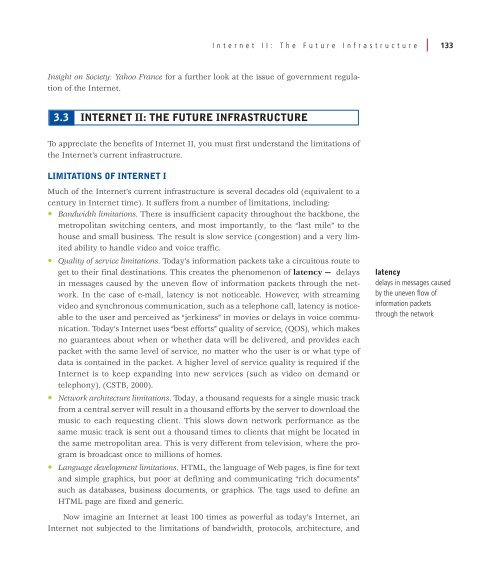The Internet and World Wide Web: E-commerce Infrastructure
The Internet and World Wide Web: E-commerce Infrastructure
The Internet and World Wide Web: E-commerce Infrastructure
Create successful ePaper yourself
Turn your PDF publications into a flip-book with our unique Google optimized e-Paper software.
<strong>Internet</strong> II: <strong>The</strong> Future <strong>Infrastructure</strong> 133<br />
Insight on Society: Yahoo France for a further look at the issue of government regulation<br />
of the <strong>Internet</strong>.<br />
3.3 INTERNET II: THE FUTURE INFRASTRUCTURE<br />
To appreciate the benefits of <strong>Internet</strong> II, you must first underst<strong>and</strong> the limitations of<br />
the <strong>Internet</strong>’s current infrastructure.<br />
LIMITATIONS OF INTERNET I<br />
Much of the <strong>Internet</strong>’s current infrastructure is several decades old (equivalent to a<br />
century in <strong>Internet</strong> time). It suffers from a number of limitations, including:<br />
• B<strong>and</strong>width limitations. <strong>The</strong>re is insufficient capacity throughout the backbone, the<br />
metropolitan switching centers, <strong>and</strong> most importantly, to the “last mile” to the<br />
house <strong>and</strong> small business. <strong>The</strong> result is slow service (congestion) <strong>and</strong> a very limited<br />
ability to h<strong>and</strong>le video <strong>and</strong> voice traffic.<br />
• Quality of service limitations. Today’s information packets take a circuitous route to<br />
get to their final destinations. This creates the phenomenon of latency — delays<br />
in messages caused by the uneven flow of information packets through the network.<br />
In the case of e-mail, latency is not noticeable. However, with streaming<br />
video <strong>and</strong> synchronous communication, such as a telephone call, latency is noticeable<br />
to the user <strong>and</strong> perceived as “jerkiness” in movies or delays in voice communication.<br />
Today’s <strong>Internet</strong> uses “best efforts” quality of service, (QOS), which makes<br />
no guarantees about when or whether data will be delivered, <strong>and</strong> provides each<br />
packet with the same level of service, no matter who the user is or what type of<br />
data is contained in the packet. A higher level of service quality is required if the<br />
<strong>Internet</strong> is to keep exp<strong>and</strong>ing into new services (such as video on dem<strong>and</strong> or<br />
telephony). (CSTB, 2000).<br />
• Network architecture limitations. Today, a thous<strong>and</strong> requests for a single music track<br />
from a central server will result in a thous<strong>and</strong> efforts by the server to download the<br />
music to each requesting client. This slows down network performance as the<br />
same music track is sent out a thous<strong>and</strong> times to clients that might be located in<br />
the same metropolitan area. This is very different from television, where the program<br />
is broadcast once to millions of homes.<br />
• Language development limitations. HTML, the language of <strong>Web</strong> pages, is fine for text<br />
<strong>and</strong> simple graphics, but poor at defining <strong>and</strong> communicating “rich documents”<br />
such as databases, business documents, or graphics. <strong>The</strong> tags used to define an<br />
HTML page are fixed <strong>and</strong> generic.<br />
Now imagine an <strong>Internet</strong> at least 100 times as powerful as today’s <strong>Internet</strong>, an<br />
<strong>Internet</strong> not subjected to the limitations of b<strong>and</strong>width, protocols, architecture, <strong>and</strong><br />
latency<br />
delays in messages caused<br />
by the uneven flow of<br />
information packets<br />
through the network

















